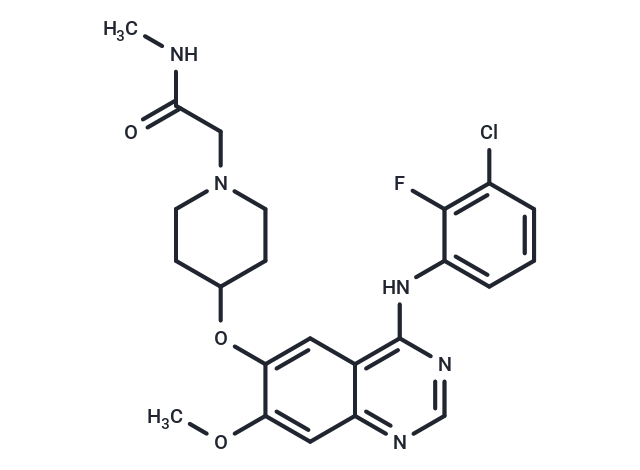Shopping Cart
- Remove All
 Your shopping cart is currently empty
Your shopping cart is currently empty

Sapitinib (AZD-8931) , a reversible, ATP competitive inhibitor of EGFR(IC50=4 nM), ErbB2(IC50=3 nM) and ErbB3(IC50=4 nM), is more effective over Gefitinib or Lapatinib against NSCLC cell, 100-fold more specific for the ErbB family over MNK1 and Flt.

| Pack Size | Price | Availability | Quantity |
|---|---|---|---|
| 2 mg | $32 | In Stock | |
| 5 mg | $52 | In Stock | |
| 10 mg | $79 | In Stock | |
| 25 mg | $113 | In Stock | |
| 50 mg | $169 | In Stock | |
| 100 mg | $252 | In Stock | |
| 1 mL x 10 mM (in DMSO) | $54 | In Stock |
| Description | Sapitinib (AZD-8931) , a reversible, ATP competitive inhibitor of EGFR(IC50=4 nM), ErbB2(IC50=3 nM) and ErbB3(IC50=4 nM), is more effective over Gefitinib or Lapatinib against NSCLC cell, 100-fold more specific for the ErbB family over MNK1 and Flt. |
| Targets&IC50 | ErbB2:3 nM, EGFR:4 nM, ERB3:4 nM |
| In vitro | Sapitinib shows different potency to NSCLC and SCCHN cell lines. Sapitinib has high sensitivity to PC-9 cells (EGFR activating mutation) with GI50 of 0.1 nM and low activity to NCI-1437 cells with GI50 above 10 μM. Sapitinib exhibits more potency against phospho-EGFR, phospho-erbB2 and phospho-erbB3 than either lapatinib or gefitinib in PE/CA-PJ41, PE/CA-PJ49, DOK and FaDu cells. [1] |
| In vivo | Sapitinib reveals antitumor activity in BT474c, Calu-3, LoVo, FaDu and PC-9 xenografts. Sapitinib could reduce p-Akt, Ki67 expression and p-ERK in BT474c xenografts following acute treatment. Sapitinib also causes induction of the M30 apoptosis marker. Furthermore, Sapitinib shows greater proapoptotic effect compared with gefitinib and lapatinib in LoVo xenografts. [1] |
| Kinase Assay | Isolated kinase assays: The intracellular kinase domains of human EGFR and erbB2 are cloned and expressed in the baculovirus/Sf21 system. The inhibitory activity of AZD8931 is determined with ATP at Km concentrations (0.4 mM for erbB2 and 2 mM for EGFR) using the ELISA method. |
| Cell Research | To determine the antiproliferative activity against cell lines grown in vitro, AZD8931 is tested in a panel of NSCLC and SCCHN cell lines. Cells are incubated for 96 hours with AZD8931 (0.001-10 μM). Viable cell number is determined by 4 hours of incubation with MTS Colorimetric Assay reagent and absorbance measured at 490 nm on a spectrophotometer. (Only for Reference) |
| Alias | AZD-8931 |
| Molecular Weight | 473.93 |
| Formula | C23H25ClFN5O3 |
| Cas No. | 848942-61-0 |
| Smiles | CNC(=O)CN1CCC(CC1)Oc1cc2c(Nc3cccc(Cl)c3F)ncnc2cc1OC |
| Relative Density. | 1.339 g/cm3 |
| Storage | Powder: -20°C for 3 years | In solvent: -80°C for 1 year | Shipping with blue ice/Shipping at ambient temperature. | ||||||||||||||||||||||||||||||
| Solubility Information | Ethanol: < 1 mg/mL (insoluble or slightly soluble) H2O: < 1 mg/mL (insoluble or slightly soluble) DMSO: 38 mg/mL (80.18 mM), Sonication is recommended. | ||||||||||||||||||||||||||||||
Solution Preparation Table | |||||||||||||||||||||||||||||||
DMSO
| |||||||||||||||||||||||||||||||

Copyright © 2015-2025 TargetMol Chemicals Inc. All Rights Reserved.